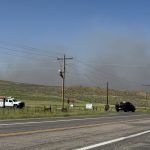Steamboat’s water future tied to Lake Powell

Tom Ross
Other presenters at the Steamboat State of the River meeting included:
• Nolan Doesken, retired state climatologist• Kevin McBride, manager of the Upper Yampa Water Conservancy District
• Zack Smith, attorney with the Colorado Water Trust
• Erin Light, the Colorado Division 6 state water engineer
• Jackie Brown, chair of the Yampa-White-Green River Roundtable
STEAMBOAT SPRINGS — The new general manager of the Colorado River District told an audience in Steamboat Springs that the continuing decline of water levels in Lake Powell, 413 highway miles from Steamboat Springs on the border of Utah and Arizona, is becoming worrisome for communities and water rights holders on Colorado’s Western Slope.
“The key with Lake Powell is that it is our river savings account,” Andy Mueller told a gathering of more than 200 people who packed into the Steamboat Springs Community Center Tuesday night for the Steamboat State of the River meeting, less than 50 feet from the banks of the Yampa River.
The upper basin states are obligated to send, on average, 7.5 million acre feet of water annually to the lower basin states. But seven years of sub-par mountain snowpacks that feed the river and its tributaries, including the Yampa River, have reduced the annual inflow to Lake Powell to the range of 3.2 million acre-feet, causing Mueller and his staff to keep a close eye on reservoir levels.
California is already consuming more than it is allotted under a historic multi-state compact, and Colorado’s growing and increasingly thirsty Front Range is always looking for more water. Historically, that has placed a target on the relative abundance of water in the Colorado River Basin.
Less understood, Mueller said, is the Colorado River District’s stake in power generation at Glen Canyon Dam, where water levels are coming perilously close to dropping below the intakes for the power plant.
“It really starts with power generation at Lake Powell,” Mueller said. “That dam is a cash register for those of us on the river. It pays for the Colorado Endangered Fish Program, which allows all of us in Colorado to continue to divert water while the endangered fish are being protected.”
Ag water rights dominate Colorado District
Mueller assumed leadership of the 15-county Colorado River District on Colorado’s Western Slope from longtime director Eric Kuhn, who retired late last year. The District’s 25 employees are based in Glenwood Springs, and Routt County Commissioner Doug Monger is a member of its board.
The district was created by the Colorado Legislature in 1937 to advocate for its constituents and to be the primary water policy and planning agency in the basin.
Mueller told his Steamboat audience that agricultural water rights continue to be of preeminent importance in the district.
“On the Western Slope, try to picture what it would look like without ag. It is a very different world if we don’t have irrigated agricultural land,” he said. “That’s where the water is. Eighty percent of the water consumed on the Western Slope is in ag. We have to protect this agriculture, and a lot of that has to do with agricultural water rights.”
But it won’t be easy to accomplish, Mueller cautioned.
Future water
The district represents about 28 percent of the physical land mass in Colorado but is home to just 500,000 of the 5 million people in the state. And 57 percent of the water produced statewide comes from the Colorado River District.
“Eighty percent of the water in Colorado begins on the Western Slope,” Mueller said. “And 80 to 90 percent of the people live on the other side,” of the Continental Divide.
“Our purpose is to protect the water of the basin for the people who live here for their use,” Mueller said. “We are also charged with our interstate obligation.”
Lake Powell, backed up by Glen Canyon Dam, just above the Grand Canyon, is where the Rocky Mountain states, including Utah, Wyoming and the northern portions of Arizona and New Mexico store water to ensure they can meet their obligations to send water to the lower basins states including California, Nevada and southern New Mexico and Arizona.
As of 1999 the reservoir was almost full. But subsequent drought years, notably 2002, drew the reservoir down. It took until 2012 to slowly re-build storage in the vast reservoir, but snowpacks in the Colorado Basin have not been generous since.
As winters have grown milder, river flows are sapped and extended growing seasons are also resulting in plants absorbing more of the available water.
“We’re working on cloud seeding, but you have to have storm events in order to hit them with the silver iodide,” Mueller said.
To reach Tom Ross, call 970-871-4205, email tross@SteamboatToday.com or follow him on Twitter @ThomasSRoss1.

Support Local Journalism

Support Local Journalism
Readers around Steamboat and Routt County make the Steamboat Pilot & Today’s work possible. Your financial contribution supports our efforts to deliver quality, locally relevant journalism.
Now more than ever, your support is critical to help us keep our community informed about the evolving coronavirus pandemic and the impact it is having locally. Every contribution, however large or small, will make a difference.
Each donation will be used exclusively for the development and creation of increased news coverage.










